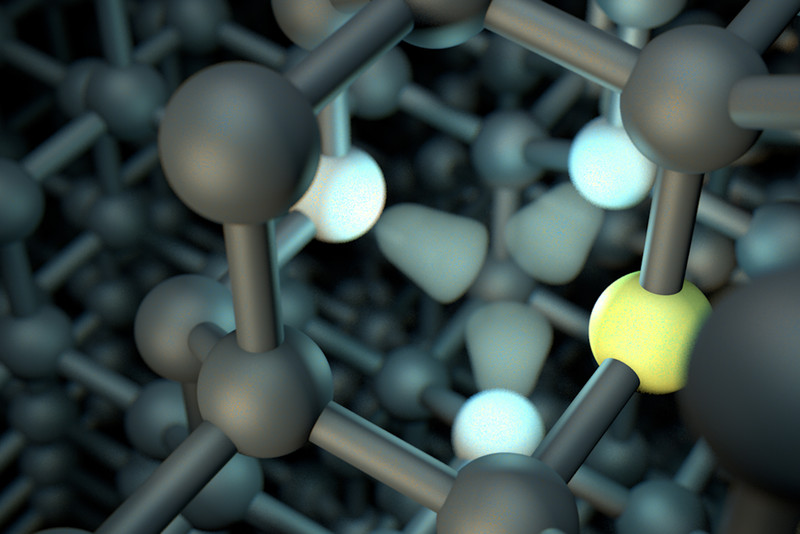2018-02-13
With quantum particles, information can be stored and manipulated – this is the basis of many very promising technologies, such as extremely sensitive quantum sensors, quantum communication or even quantum computers. There is, however, a significant problem: it is difficult to store information in a quantum physical system for a long period of time. The quantum information tends to dissipate within fractions of a second due to interactions with the environment.
At TU Wien it has now been possible to store quantum information for hours at a time using special diamonds. This makes the quantum information even more stable than the conventional information stored in the working memory of our computers. The results of this research have now been published in the journal "Nature Materials".

At some locations in the crystal lattice, a carbon atom (white) is missing, and at the neighbouring site there is a nitrogen atom (yellow).
Diamonds with defects
A special quantum system is being utilised at TU Wien, which has been sparking great interest all over the world. "We are using tiny diamonds intentionally seeded with small defects," says Johannes Majer, Research Group Leader at the Institute of Atomic and Subatomic Physics at TU Wien. Normally a diamond is composed only of carbon atoms. By irradiating the diamond, it is possible to introduce a nitrogen atom into the diamond structure in place of a carbon atom at certain points, which then leaves an unoccupied point in the crystal lattice next to it. This "lattice defect" is known as an NV- centre or nitrogen-vacancy centre. The nitrogen atom and the empty site can assume different states, so this lattice defect site can be used to store an information quantum bit.
The decisive issue is for how long this information remains stable. "The time scale in which a quantum bit typically loses its energy and with it the stored information is technologically one of the most important characteristics of such a quantum bit," explains Thomas Astner, the lead author of the publication. "Understanding precisely the reason for the energy loss and the speed of this process is therefore crucial."
For the first time, scientists at the Institute of Atomic and Subatomic Physics at TU Wien have now been able to experimentally determine the characteristic period during which the diamond errors lose their quantum information. The diamonds were coupled to microwaves so that quantum information can be written and read. The special microwave resonator used for this purpose was developed by Andreas Angerer at TU Wien in 2016. It can be used to determine, with great precision, how much energy is still being stored in the diamond.
Record times
The measurements were carried out at very low temperatures, just above the absolute zero temperature, at 20 millikelvins. Heat would disturb the system environment and erase the quantum information. It became apparent that the diamonds can store their information over several hours, much longer than was thought possible. "The information in the D-RAM chip of an ordinary computer memory is much less stable. There the energy is lost within a few hundred milliseconds, meaning that the information then has to be refreshed," says Johannes Majer.
Not all diamonds with defects offer the same storage periods. The record is held by a special diamond manufactured by the team working with Junichi Isoya at the University of Tsukuba in Japan. It was irradiated with electrons over several months to generate as many N-V centre defects as possible without introducing any other detrimental effects. A quantum storage period of 8 hours could be measured in this diamond.
"Initially we could hardly believe these wonderful results," says Johannes Majer. The phenomenon was therefore investigated thoroughly using computer simulations. Johannes Gugler and Professor Peter Mohn (also at TU Wien) carried out complex calculations that led to the explanation that the extraordinary stability of diamond quantum storage is due to the particularly stiff diamond lattice. "Whereas other materials display lattice vibrations that can rapidly lead to the loss of the information stored, the coupling of quantum information to the lattice vibrations is very weak in diamonds and energy can be stored for hours," says Thomas Astner.















